Yvette Greslé talks to Bob Lee of The Collective, a founder member of a growing national network of art collectors who buy and share contemporary art within individual groups.
The founding group – which is based in London – has been going for over 10 years, and their collection includes works by Bobby Dowler, Fiona Banner and Tracey Emin. The idea is that buying and collecting contemporary art is for anyone. Groups can pool resources (an agreed monthly amount) and buy art together, circulating it on rotation in homes and workplaces. Bob’s group have extended their collecting practice to include Performance Art – ‘Home Suite’, a performance piece by Katharine Fry was commissioned in 2008.
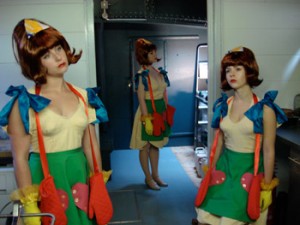
YG: Tell me about the process of commissioning a performance artist. What interests you about the idea of collecting performance art?
BL: The piece we commissioned was a work by an artist called Katharine Fry. When we first started collecting as a group we decided that a key objective for us was to collect the contemporary art of the day. When we started collecting (late 1990s/2000) it coincided with a time when artistic practice was particularly diverse, and performance art was one of a genre among many others that we felt we should collect. It was quite a natural process in a way.
YG: How do you think about contemporary art?
BL: While contemporary art can be defined in very broad terms, it is important to stress that we are primarily interested in what we describe as critically engaged art.
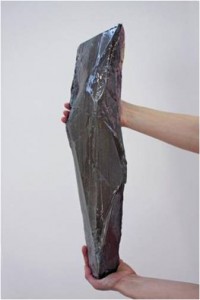
YG: What draws you to an artist’s work personally?
BL: I look for work that speaks to me in some way whatever genre it is – whether it’s video work, performance, painting, sculpture or mixed media. If it speaks to me in some way or the issues that it’s addressing interest me I’m drawn to it. It’s not always a matter of an instantaneous appreciation of a work. Sometimes it takes time for me to appreciate a work, and for that work to grow on me. Some of the work can be quite complicated. Some of the issues that the artist is dealing with can be quite complicated, and sometimes it requires an effort. Part of the journey is making the effort.
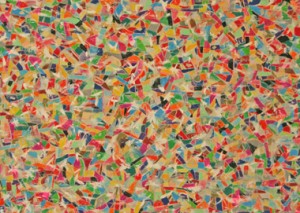
YG: Which of the works in your collection are most interesting to you?
BL: That’s extremely difficult. I think perhaps the most interesting work is the performance work that we commissioned. In 2008, the buying group at the time (when it was their turn) said that they were going to explore buying or commissioning a performance work. We’d had no experience of doing that and so the buying panel (as we sometimes call them) had to do quite a lot of research. Research into what art was out there within our budget.
YG: What was the research process? Did you talk to curators and galleries?
BL: Yes. The buying panel also sought advice from the Arts Council. We were advised to advertise on a website used by performance artists (where they exchange information and so on). A number of proposals came forward, and in the end a proposal by Katharine Fry was settled on. Katharine’s proposal involved a performance in all of our households. In our group there are 7 households. One of our members lived on a boat and it was going to be performed there too. We thought her proposal responded very well to the collective, to our model and what we do.

YG: Did she start out with one specific performance that would be re-enacted in each space?
BL: No her approach was a narrative examining domesticity and relationships from a woman’s perspective. The narrative charted the progress of a relationship over time. In our case it was performed over 7 weeks on a different day of the week in different households. Thematically each performance moved on from the previous one. So broadly it started off with a relationship in the first flush of romance: the first performance was called Silliness, and then moved on to Seduction, Seriousness, Solitude, Sorrow, Seething and Senselessness. The performances charted the evolution of a relationship and its degeneration. Throughout all the performances there was this ritual of activity that went on. But they became more dark and frenzied as the days progressed.
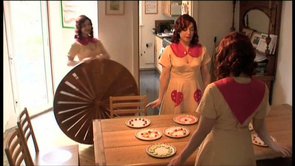
YG: What did it feel like to have this performance art in your private space?
BL: We had a limited budget, and Katherine raised additional funding from the Arts Council. Once the Arts Council agreed to be part funders of the performance, and the project certain rules applied. We were required to invite members of the public to come to the performance, and some members were a bit apprehensive about it. Members of the public coming into the home, but it happened.
YG: That adds a public dimension to the private act of collecting. From what I understand of the collective there’s a lot of discussion with galleries, curators, arts funders, artists. You’re not just doing this on your own. You’re constantly engaging and talking.
BL: Obviously with the performances we had always intended to invite friends, people from the art world that we knew to the performances. The new element of it was members of the public that we didn’t know coming along. This was perhaps the most experiential work we’ve commissioned, purchased. It generated a lot of discussion and debate within the group. Firstly Katharine researched the piece and researched the households and so it started off with Katherine and her team arriving at our homes early in the morning. They would spend the day there, and among other things they catalogued everything in the home. So they were looking through chests of drawers, writing everything up and cataloguing it. They recorded all the sounds of the house: children arriving, things going on, and so at times there were some tensions. These people were in our house.
YG: I think as an artist to perform or to put your work out is a very vulnerable feeling and here you have a blurring between the collector and the artist. Here the collector feels that vulnerability.
BL: On the one hand it was quite exhilarating that this piece was emerging, and on the other hand some of the time it felt intensely intrusive (members discussed this). But we went along with it.
YG: Did you record the performances or were you happy to see it just as something ephemeral ?
BL: There were different opinions about that. I think the original intention was to document the performance in some way. Katharine was quite keen as a performance artist to document it in an appropriate way from her perspective. I think people were so enthralled by the performances. There was a sense that we would love to have some memory of it. Photographs, video. Some of our members videoed it themselves. Katherine had a video person there over the performances and lots of stills were taken. We discussed it a lot in the group. We don’t have an official document. It has become a point of debate. My personal view is I don’t feel the need for a document. I think I subscribe to a view put forward by Peggy Phelan that almost by definition performance is in the moment. Everyone thought the performance was stunning and it’s still talked about.
YG: Which theme was for the boat?
BL: I think it was sorrow, and it had the feeling of sorrow about it. It was one of the most strange and beautiful performances because at the time of the performance I think the tide was coming in and the boat swayed with the water while the performance was happening.

YG: Is there anything you’d like to tell us about the collective more generally?
BL: We’re not about collecting trophies for their sake and performance art is part of that. If you collect work then collecting performance should be a natural part of it. In a debate I took part in some of the collectors put forward quite forcibly that if they commission performance they want exclusive ownership of the documentation. Other collectors say that they simply wouldn’t collect this kind of ephemeral work. Some collectors argue that video is problematic enough let alone collecting performance. I’ve become quite evangelical about performance arguing that it’s part of contemporary art practice and that artists who work in performance should be supported.
YG: Is there work that’s unsettling in the context of a domestic space?Do you ever have conflicts about unsettling work in your personal space?
BL: Yes, some of the work we have is quite unsettling, the images are quite unsettling. Perhaps what’s even more interesting is how people who come to our homes engage with the work. People who know about what we do enjoy coming to see new work. But some people find it quite disturbing and that’s an interesting debate in itself. A common refrain is ‘Why is that up?’ or ‘Why is that art?’ This sets up a new dialogue: debate and discussion with accidental audiences in a way. You can experience art not just in a gallery or in a museum but in a domestic space and that’s really interesting.
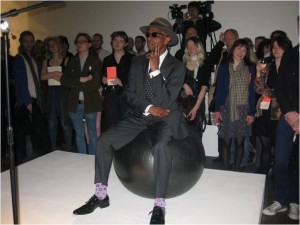
For more information about The Collective see www.the-collective.info.
See Katharine Fry’s website: www.katharinewheel.com



